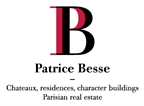4 km from the Alabaster Coast, in parklands of almost 14 hectares, a 17th century listed chateau with numerous outbuildings - ref 967349
4 km from the Alabaster Coast, in parklands of almost 14 hectares, a 17th century listed chateau with numerous outbuildings.
In a triangle between Rouen, Dieppe and Fécamp, the chalk "Plateau de Caux Maritime" is a predominantly rural region, between land and sea, plains and woods. Countless hiking trails and panoramic views of the sea are to be found, as are some of the most beautiful villages in France. It takes less than an hour to drive to Rouen, and less than 30 minutes to Yvetot station (with its links to Paris) and to the A29 motorway (to Le Havre and Deauville). The port of Saint-Valery-en-Caux is a few kilometres away. Dieppe or Le Havre provide easy ferry links to the UK. There is a small airfield nearby. A village where you can find all your daily needs is only a stone's throw from the property.
A quiet country road leads through fields and groves to a wrought-iron gate supported by brick pillars topped by sculptures. The caretaker's house, the former kennel and the dovecote are located at the entrance to the park. A driveway lined with tall trees leads to the chateau. It is surrounded by gravel areas followed by vast lawned grounds which separate it, on one side, from three outbuildings and, further ahead, from the stables. At the rear, the orchard, the "pavillon d'octroi" (local customs lodge) and the rose garden with the two swimming pools are located beyond the lawns. The woodlands are situated on the edge of the property.
The chateauThis Louis XIII style chateau was built at the very beginning of the 17th century. The main building is flanked by two square towers on the main facade, which is divided into five bays. In the centre, the entrance door is topped by a French window protected by a balcony and its wrought iron balustrade, and further up an imposing clock and a bell tower. In the 19th century, two wings were added on the same alignment as well as three octagonal half-timbered towers on the rear facade. The brick walls are supported by a dressed stone foundation. Darker geometric brick patterns can be made out on the older walls. They are topped by four-pitched slate roofs. The three towers on the rear facade are protected by hexagonal hipped roofs. The hip dormer windows are slightly arched. The frames of the openings, the string courses and the in-and-out corner quoins are of dressed stone. The facades and roofs of the main building are listed as Historic Monuments.
The ground floor
In the central bay, a flight of steps leads to the glass double entrance door with small panes. It opens into a full-depth hall with, at the other end, the wooden staircase partially housed in an octagonal tower on the rear façade. It is lit on each level by a tall rectangular window; a door opens to the outside. The straight strip parquet and waxed concrete floor, the red brick walls and the large whitewashed walls set the tone of a refined and very contemporary decor. Tall double doors open on one side into the dining room, a cloakroom and toilets, followed by a very large kitchen. On the other side is the large sitting room connecting with a boudoir, a library and a room used as a small drawing room. The boudoir and the drawing room can also be accessed via the secondary staircase with a door opening out to the rear of the building. A third staircase leads from a small passageway off the kitchen to the two levels of the part of the chateau still in need of restoration. All of the decorative features have been preserved, including the herringbone parquet flooring and the woodwork in the large sitting room listed as a Historic Monument. The high painted or natural wood panelling, the coffer or beamed ceilings. Each room is adorned with marble or stone fireplaces, as well as interior window shutters. Only the kitchen has been completely redesigned. This room occupies the entire ...


